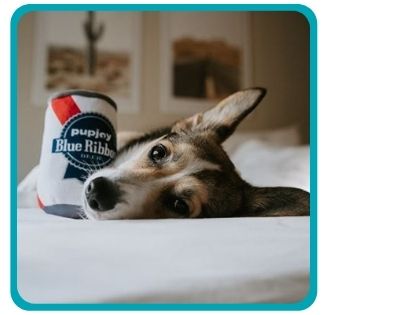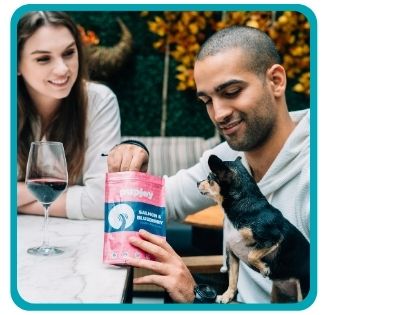This is a featured guest article from PupJoy, an online shopping experience for pet parents to find honest, healthy high-quality dog goods from socially responsible makers.
Author: Dustin McAdams, PupJoy founder and CEO
Many of us dog parents have become more conscious about our own health and wellness. And to the benefit of our dogs, we’ve become more conscious about theirs too.
When it comes to our dogs, we are willing to do whatever it takes to keep them healthy and happy. More than ever, our pups are being treated like members of the family, and along with that comes shifting ideas about the types of products we purchase for them.
We want food and treats that are healthy, responsible, and sustainable. We want natural. And that is part of the challenge.
Wait, Natural is Good, Right?!?
Yes, absolutely, natural is good. And…
It generally holds true that good stuff going in means better health and wellness for our pups. Natural = better, healthier.
Natural ingredients are easier to digest, provide essential nutrients that are easier to absorb, help foster healthier skin, coat, mobility, immunity, and more.
And also…
Deciphering what is really good stuff isn’t always so easy. “Natural” is unfortunately kind of marketing BS in the pet industry, fueled by our increased desire for all things healthy and by governing standards without a lot of teeth.
How would you describe “natural” to a friend? Maybe from nature… safe… nothing artificial… healthy?
That would make sense.
But that’s not always the way it is…
If you want to label dog treats (or food) as natural, it is governed by the Association of American Feed Control Officials. You have to meet AAFCO’s definition, which is a little nebulous at best.
Treats and foods described as natural are not necessarily healthy, or even logically natural in some cases. Even though they may be technically compliant, they still may contain artificial ingredients.
As AAFCO states: “A feed or feed ingredient can contain trace amounts of chemically synthetic compounds and still be considered natural.” - and - “Not containing any additives or processing aids that are chemically synthetic except in amounts as might occur in good manufacturing practices.”
Huh? Read that last one again. They can’t… unless they needed to?!?!
If you were in a store looking at a dog treat package, would you interpret this statement as disclosing that the product uses artificial ingredients: “Natural with added vitamins, minerals and trace nutrients”?
Per AAFCO, that phrase “is a disclaimer—not a boast—that identifies the synthetic ingredients in an otherwise natural product”.
It’s that type of hazy definitions and standards that enables some not-so-healthy stuff to be marketed as natural. And some of the artificial stuff is pretty darn nasty.
The unfortunate truth is, as a dog parent, the burden is often on you, fair or not. If you’re looking for healthy stuff for your dog, you have to look at the ingredient panel, not the front of the bag, and know what to look for. You might be shocked at what's actually in some dog food and treats.
PupJoy's Banned Artificial & Dangerous (BAD) Ingredients
As a company, we just completely ban anything artificial or dangerous in dog treats or foods that we carry. Our goal is to help remove the burden on dog parents of policing ingredients and allow them to shop with trust.
Everything at PupJoy has to meet our standards for responsibility and sustainability. And at the top on that list of standards is health and safety. So, we draw a hard line with ingredients that are potentially harmful. We simply won’t carry products that include them.
Dustin joined us on our podcast Pet Lover Geek! Dustin shares even more tips about finding the perfect food, and dives into what it means to be a sustainable company in the pet industry. Listen now!
BAD Ingredients Cheat Sheet
Here are some of the worst offenders to look out for:
RAWHIDE
This one probably goes without saying, but I will anyway. We have never and will never sell rawhide. Aside from containing very little nutritional value, they can be dangerous. Whether your dog is a power chewer or not, most dogs will inevitably break off pieces that could cause choking or an intestinal blockage. Further, rawhide is processed using a variety of toxic chemicals. Some of those might include formaldehyde, bleach, sodium sulfide, and glue.
ARTIFICIAL PRESERVATIVES
Some artificial preservatives can have several harmful health effects on dogs, from digestive and organ issues to cancer. Common preservatives to avoid include:
- BHA (Butylated Hydroxyanisole) and BHT (Butylated Hydroxytoluene) have both been linked to cancer by sources like the World Health Organization and as well as the US National Toxicology Program. They are both also incredibly hard for dogs to digest so they can also aggravate food allergies and intolerances.
- Propyl Gallate (also listed as Gallic Acid or Propyl Ester) is often used in conjunction with BHA/BHT. It can mimic the negative effects of estrogen, and is linked to cancer, liver, kidney, breathing and skin issues.
- Propylene Glycol, a relative to antifreeze (Ethylene Glycol) and it is banned in the European Union from being added to dog foods. It is disruptive to healthy digestion and has been shown in studies to cause nervous system damage, intestinal lesions/blockage, and cancer.
- Ethoxyquin was originally developed as a chemical pesticide for fruit, before being used as a preservative. Studies have shown links to kidney and liver damage, hyperthyroidism, reproductive issues, cancer, blindness, and immune deficiency syndrome.
- TBHQ (tertiary butylhydroquinone) contains petroleum-derived butane and is also used to stabilize explosive compounds and make varnishes. It has been linked to stomach cancer and can damage cellular DNA.
- Sodium Metabisulphite can trigger severe allergic reactions in dogs. Exposure can also cause nervous system damage and issues with circulation.
- Sodium Nitrite is potentially highly carcinogenic.
- Carrageenan has been linked to cancer and severe inflammation in dogs, even in small doses.
ARTIFICIAL FLAVORS
Many flavor additive substances aren’t made from real foods (fruits, vegetables, spices, plants, eggs, meats, fish or dairy) and can cause food sensitivities and allergies.
ARTIFICIAL SWEETENERS
Dogs can’t process artificial sweeteners. Xylitol and other sugar alcohols can cause vomiting, lethargy and loss of coordination. Sorbitol is a synthetic sweetener that is linked to arthritis and is known to cause a range of digestion issues including vomiting, diarrhea, stomach cramping, and bloody stools.
ARTIFICIAL COLORS
Artificial color dyes like come with names like caramel coloring, red #40, blue #2, and yellow #5. They do not add any nutritional value – they only make things look more visually appealing to us humans - and they can also trigger a range of health issues in dogs like hyperactivity, allergic reactions, organ damage, and cancer.
DANGEROUS BY-PRODUCTS
Animal By-Product means everything that is left of an animal carcass once the meat and bones have been removed. Essentially, slaughterhouse scraps. It is created by cooking animal carcasses at such a high heat that it melts the material. This can include diseased, rotten, and euthanized animal flesh. These products are not healthy for your dog as they are heavily processed with little nutrition left, hard to digest, and can come from dangerous sources.
DANGEROUS MEAT MEALS
Some dog foods or treats will list "meat meal" or simply just "meat" as an ingredient. When manufacturers include this nondescript language on an ingredient list, it is likely the worst source of meat that your dog can get, often is a mixture of several types of meats including dead livestock or zoo animals. Yes, you read that right. Like by-products, they’re also heated extensively to remove pathogens that exist, which also removes most nutrients and makes them difficult to digest.
DANGEROUS FATS
While good animal fats can be healthy for dogs, the FDA regulations for generic animal fat in dog food allows the fat to be chemically preserved and sourced from "4D animals" -dead, diseased, dying, or disabled. Tallow is chemically preserved as well and can include rancid restaurant grease.
Good Things to Look For
The good news is that once you know what to look out for, the bad stuff, you can cut through the marketing spin and focus on the good stuff. The healthiest food & treats use real, nutrient-packed ingredients and natural preservatives. Ones that you can identify.
Limiting ingredients is a good rule of thumb. Generally, the fewer the better, although this varies by product type. For example, soft and chewy treats will always have more ingredients than say a single protein jerky treat. But within categories of treats and food, normally less is better. Also, focus on the ingredients listed in priority order - the sooner an ingredient appears on the list, the more of it that is included.
These are almost always good things to look for in your dog’s food and treats:
WHOLE-FOOD INGREDIENTS
Such as single source proteins and minimally processed fruits, vegetables, and grains.
ORGANIC INGREDIENTS
Are even better, as they are less likely to contain contaminants, and they receive extra scrutiny from inspectors.
FUNCTIONAL INGREDIENTS
Are natural ingredients that have health-promoting benefits, containing nutrients and components like glucosamine and chondroitin (joint health), essential fatty acids (skin, coat & joint health), antioxidants (joint, cognitive, heart & immune health), phytonutrients (skin, eye, heart & joint health), amino acids (skin, coat & immune health), fiber (digestive health), & collagen (joint, skin, coat & digestive health). Look for “super food” ingredients like these as great natural sources:
- Coconut Oil & Olive Oil have antioxidants & essential fatty acids
- Eggs have amino acids, essential fatty acids & vitamins
- Oily Fishes like salmon and sardines have essential fatty acids & vitamins
- Blueberries & Watermelon have antioxidants & vitamins
- Carrots, Sweet Potatoes & Pumpkin have phytonutrients, vitamins & fiber
- Bone Broth has collagen, glucosamine, chondroitin & amino acids
- Dark Leafy Greens like Kale have phytonutrients, antioxidants, & vitamins
- Chia & Flax Seeds have antioxidants, essential fatty acids, fiber
- Quinoa has all 8 essential amino acids, minerals, & phytonutrients
- Turmeric & Ginger have antioxidants and they are anti-inflammatory, antiviral, and antifungal
UPCYCLED INGREDIENTS
Are great for the environment and your dog! They are perfectly healthy ingredients that otherwise would have gone to waste due to cosmetic imperfections or unused portions. You can find many examples in our Eco-Friendly Treats Collection.
SAFE SOURCES
Treats made in the USA & Canada are typically the best bet for a lot of treats, although there are good sources in countries beyond North America too. However, I would never recommend any treats produced in China. South America is great for some of the best grass-fed free-range chews like bully sticks. More importantly, make sure you are confident in the brand and the seller. I’m biased, but we do things in a way that I believe is best for safety and trust. We have a curated selection of products that meet our strict standards. We work directly with manufacturers, so we know them and their products intimately, and we list the place of origin on every product.
NATURAL PRESERVATIVES
Products with no preservatives are often difficult to find due to a very limited shelf life of the products. For most food and treats, preservatives are necessary. Natural preservatives like vitamins C (ascorbic acid) and E (mixed tocopherols), Lactic Acid, and Rosemary are effective and safe.
A WAGGING TAIL!! ☺
At the end of the day, this is one of the most important things to look for… here’s to your happy, healthy dog!
If you’d like to learn more about how we Treat Better at PupJoy, you can find us at www.pupjoy.com or email me directly with any questions. I’d love to hear from you!
This is a featured guest article from PupJoy, an online shopping experience for pet parents to find honest, healthy high-quality dog goods from socially responsible makers.
Author: Dustin McAdams, PupJoy founder and CEO







